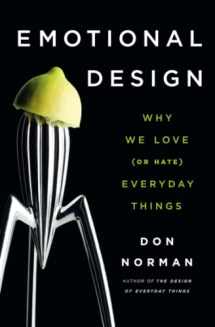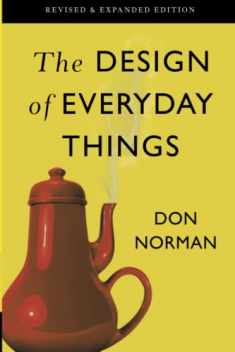
Emotional Design: Why We Love (or Hate) Everyday Things
ISBN-13:
9780465051366
ISBN-10:
0465051367
Edition:
1
Author:
Don A. Norman
Publication date:
2005
Publisher:
Basic Books
Format:
Paperback
272 pages
Category:
Design History & Criticism
,
Decorative Arts & Design
,
Arts History & Criticism
,
Consumer Behavior
,
Marketing & Sales
,
Emotions
,
Mental Health
,
Physiological Aspects
,
Psychology & Counseling
,
Cognitive Psychology
,
Behavioral Sciences
,
Cognitive
,
Psychology
,
General
,
Physiological Aspects
,
Popular Culture
,
Social Sciences
FREE US shipping
on ALL non-marketplace orders
Marketplace
from $15.67
USD
Marketplace offers
Seller
Condition
Note
Seller
Condition
New
Brand New! Not overstocks! Brand New direct from the publisher! Ships in sturdy cardboard packaging.
Book details
ISBN-13:
9780465051366
ISBN-10:
0465051367
Edition:
1
Author:
Don A. Norman
Publication date:
2005
Publisher:
Basic Books
Format:
Paperback
272 pages
Category:
Design History & Criticism
,
Decorative Arts & Design
,
Arts History & Criticism
,
Consumer Behavior
,
Marketing & Sales
,
Emotions
,
Mental Health
,
Physiological Aspects
,
Psychology & Counseling
,
Cognitive Psychology
,
Behavioral Sciences
,
Cognitive
,
Psychology
,
General
,
Physiological Aspects
,
Popular Culture
,
Social Sciences
Summary
Emotional Design: Why We Love (or Hate) Everyday Things (ISBN-13: 9780465051366 and ISBN-10: 0465051367), written by authors
Don A. Norman, was published by Basic Books in 2005.
With an overall rating of 3.8 stars, it's a notable title among other
Design History & Criticism
(Decorative Arts & Design, Arts History & Criticism, Consumer Behavior, Marketing & Sales, Emotions, Mental Health, Physiological Aspects, Psychology & Counseling, Cognitive Psychology, Behavioral Sciences, Cognitive, Psychology, General, Physiological Aspects, Popular Culture, Social Sciences) books. You can easily purchase or rent Emotional Design: Why We Love (or Hate) Everyday Things (Paperback) from BooksRun,
along with many other new and used
Design History & Criticism
books
and textbooks.
And, if you're looking to sell your copy, our current buyback offer is $0.52.
Description
Why attractive things work better and other crucial insights into human-centered design
Emotions are inseparable from how we humans think, choose, and act. In Emotional Design, cognitive scientist Don Norman shows how the principles of human psychology apply to the invention and design of new technologies and products. In The Design of Everyday Things, Norman made the definitive case for human-centered design, showing that good design demanded that the user's must take precedence over a designer's aesthetic if anything, from light switches to airplanes, was going to work as the user needed. In this book, he takes his thinking several steps farther, showing that successful design must incorporate not just what users need, but must address our minds by attending to our visceral reactions, to our behavioral choices, and to the stories we want the things in our lives to tell others about ourselves. Good human-centered design isn't just about making effective tools that are straightforward to use; it's about making affective tools that mesh well with our emotions and help us express our identities and support our social lives. From roller coasters to robots, sports cars to smart phones, attractive things work better. Whether designer or consumer, user or inventor, this book is the definitive guide to making Norman's insights work for you.
Emotions are inseparable from how we humans think, choose, and act. In Emotional Design, cognitive scientist Don Norman shows how the principles of human psychology apply to the invention and design of new technologies and products. In The Design of Everyday Things, Norman made the definitive case for human-centered design, showing that good design demanded that the user's must take precedence over a designer's aesthetic if anything, from light switches to airplanes, was going to work as the user needed. In this book, he takes his thinking several steps farther, showing that successful design must incorporate not just what users need, but must address our minds by attending to our visceral reactions, to our behavioral choices, and to the stories we want the things in our lives to tell others about ourselves. Good human-centered design isn't just about making effective tools that are straightforward to use; it's about making affective tools that mesh well with our emotions and help us express our identities and support our social lives. From roller coasters to robots, sports cars to smart phones, attractive things work better. Whether designer or consumer, user or inventor, this book is the definitive guide to making Norman's insights work for you.


We would LOVE it if you could help us and other readers by reviewing the book
Book review

Congratulations! We have received your book review.
{user}
{createdAt}
by {truncated_author}




